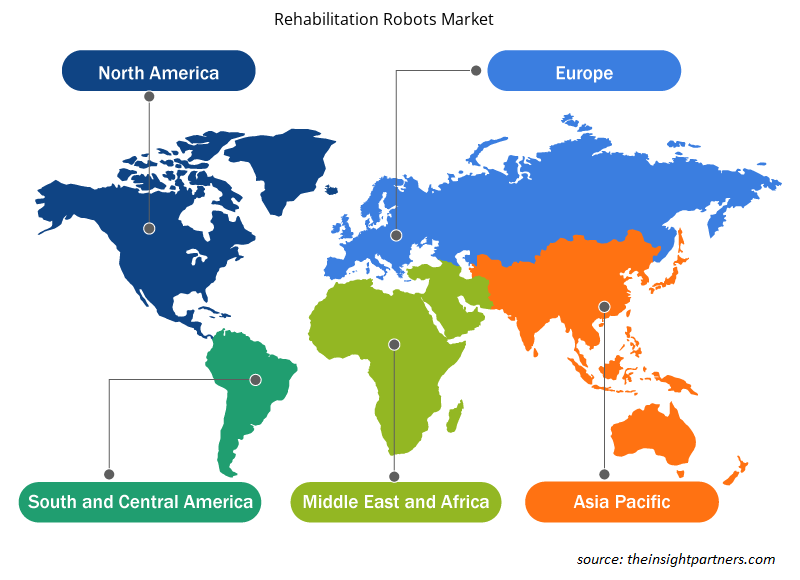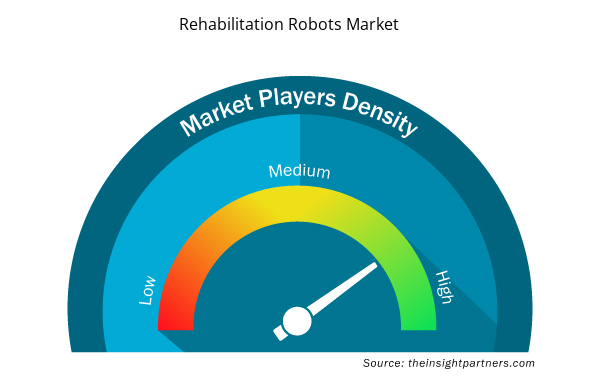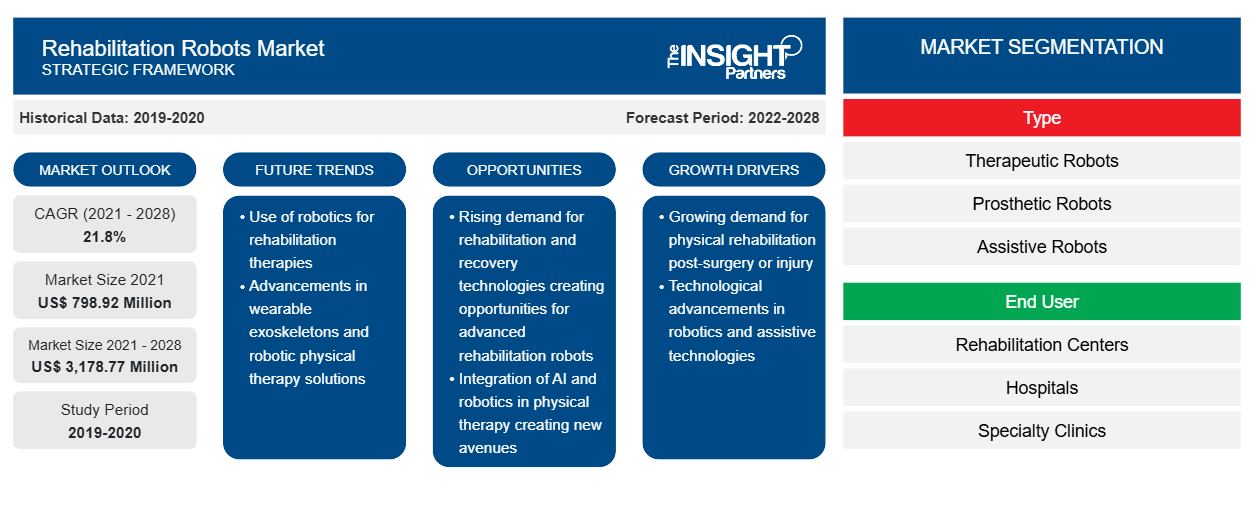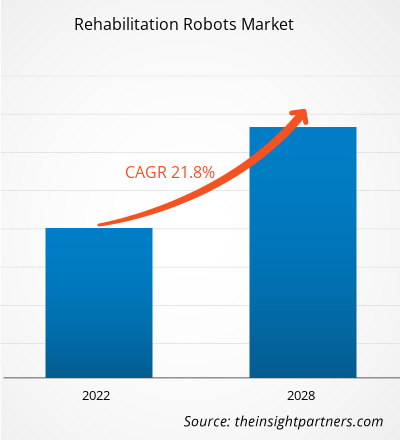Le marché des robots de rééducation a été évalué à 798,92 millions de dollars américains en 2021 et devrait atteindre 3 178,77 millions de dollars américains d'ici 2028 ; il devrait croître à un TCAC de 21,8 % de 2021 à 2028.
Les robots de rééducation sont utilisés dans le processus de récupération des patients handicapés pour se lever, s'équilibrer et marcher. Ces robots doivent suivre les humains et leurs mouvements ; par conséquent, lors de la fabrication de la machine, les fabricants doivent s'assurer qu'elle sera cohérente avec les progrès du patient. Le marché des robots de rééducation devrait connaître une croissance significative dans les années à venir en raison de facteurs tels que l'augmentation de la population gériatrique, les accidents vasculaires cérébraux et la formation assistée par robot en thérapie de rééducation. Cependant, le coût élevé des appareils freine la croissance du marché.
Informations sur le marché
Personnalisez ce rapport en fonction de vos besoins
Vous bénéficierez d'une personnalisation gratuite de n'importe quel rapport, y compris de certaines parties de ce rapport, d'une analyse au niveau des pays, d'un pack de données Excel, ainsi que d'offres et de remises exceptionnelles pour les start-ups et les universités.
- Obtenez les principales tendances clés du marché de ce rapport.Cet échantillon GRATUIT comprendra une analyse de données, allant des tendances du marché aux estimations et prévisions.
Augmentation de la population gériatrique, des accidents vasculaires cérébraux et de la formation assistée par robot en rééducation
Avec la croissance de la recherche liée à la robotique de réadaptation, la fabrication et le déploiement de robots de réadaptation thérapeutique augmentent dans le monde entier. Le Japon et la Chine font partie des pays d'Asie-Pacifique qui comptent une forte population de personnes âgées ; ces pays, ainsi que d'autres pays en développement de la région, sont témoins des progrès de la technologie médicale. Selon le ministère des Affaires intérieures et des Communications, environ 35,2 millions de personnes au Japon étaient âgées de 65 ans ou plus en 2017, et ce chiffre devrait passer à 36,2 millions d'ici 2020. Par conséquent, les grandes entreprises du secteur de la santé sont prêtes à investir dans le développement de technologies avancées pour fournir des soins aux résidents âgés de la région. Par conséquent, l'augmentation de la population âgée et la prévalence croissante des accidents vasculaires cérébraux, rendant les personnes immobilisées, sont parmi les facteurs importants qui stimulent la demande de robots de réadaptation.
La thérapie de rééducation par robot est utilisée pour fournir un entraînement de haute intensité aux patients souffrant de troubles moteurs causés par des maladies de la moelle épinière ou un accident vasculaire cérébral. L'AVC est l'une des principales causes d'invalidité grave à long terme aux États-Unis, selon les Centres pour le contrôle et la prévention des maladies (CDC). La fatigue, l'hémiparésie et les difficultés à marcher sont quelques-uns des effets d'un AVC. De plus, les robots de rééducation fournissent une formation personnalisée, axée sur les tâches, prolongée, intensive, standardisée et reproductible aux patients touchés par un AVC ou d'autres lésions cérébrales non progressives. Ainsi, la demande croissante de services de santé meilleurs et plus rapides stimule la croissance du marché global des robots de rééducation.
Informations sur les types
En fonction du type, le marché des robots de rééducation est segmenté en robots thérapeutiques, robots d'assistance, robots exosquelettes et robots prothétiques. Le segment des robots exosquelettes détenait la plus grande part du marché en 2021 et il devrait enregistrer le TCAC le plus élevé au cours de la période de prévision.
Utilisateur final
En fonction de l'utilisateur final, le marché des robots de rééducation est segmenté en hôpitaux, centres de rééducation et cliniques spécialisées. Le segment des centres de rééducation détenait la plus grande part du marché en 2021 et devrait enregistrer le TCAC le plus élevé au cours de la période de prévision.
Les acteurs opérant sur le marché des robots de rééducation ont largement adopté la stratégie d'innovation produit pour répondre à l'évolution de la demande des clients à travers le monde, ce qui leur permet également de maintenir leur nom de marque à l'échelle mondiale.
Aperçu régional du marché des robots de rééducation
Les tendances régionales et les facteurs influençant le marché des robots de rééducation tout au long de la période de prévision ont été expliqués en détail par les analystes d’Insight Partners. Cette section traite également des segments et de la géographie du marché des robots de rééducation en Amérique du Nord, en Europe, en Asie-Pacifique, au Moyen-Orient et en Afrique, ainsi qu’en Amérique du Sud et en Amérique centrale.

- Obtenez les données régionales spécifiques au marché des robots de rééducation
Portée du rapport sur le marché des robots de rééducation
| Attribut de rapport | Détails |
|---|---|
| Taille du marché en 2021 | 798,92 millions de dollars américains |
| Taille du marché d'ici 2028 | 3 178,77 millions de dollars américains |
| Taux de croissance annuel moyen mondial (2021-2028) | 21,8% |
| Données historiques | 2019-2020 |
| Période de prévision | 2022-2028 |
| Segments couverts | Par type
|
| Régions et pays couverts | Amérique du Nord
|
| Leaders du marché et profils d'entreprises clés |
|
Densité des acteurs du marché des robots de rééducation : comprendre son impact sur la dynamique commerciale
Le marché des robots de rééducation connaît une croissance rapide, tirée par la demande croissante des utilisateurs finaux en raison de facteurs tels que l'évolution des préférences des consommateurs, les avancées technologiques et une plus grande sensibilisation aux avantages du produit. À mesure que la demande augmente, les entreprises élargissent leurs offres, innovent pour répondre aux besoins des consommateurs et capitalisent sur les tendances émergentes, ce qui alimente davantage la croissance du marché.
La densité des acteurs du marché fait référence à la répartition des entreprises ou des sociétés opérant sur un marché ou un secteur particulier. Elle indique le nombre de concurrents (acteurs du marché) présents sur un marché donné par rapport à sa taille ou à sa valeur marchande totale.
Les principales entreprises opérant sur le marché des robots de rééducation sont :
- Société des laboratoires Bionik
- Cyberdyne Inc.
- Éxo
- Bionique Holdings Inc.
- Rewalk Robotics Ltée
Avis de non-responsabilité : les sociétés répertoriées ci-dessus ne sont pas classées dans un ordre particulier.

- Obtenez un aperçu des principaux acteurs du marché des robots de rééducation
Par type
- Robots exosquelettes
- Robots thérapeutiques
- Robots d'assistance
- Robots prothétiques
Utilisateur final
- Centres de réadaptation
- Hôpitaux
- Cliniques spécialisées
Par géographie
- Amérique du Nord
- NOUS
- Canada
- Mexique
- Europe
- ROYAUME-UNI
- Allemagne
- France
- Italie
- Espagne
- Reste de l'Europe
- Asie-Pacifique
- Chine
- Japon
- Inde
- Australie
- Corée du Sud
- Reste de l'Asie-Pacifique
- Moyen-Orient et Afrique
- Émirats arabes unis
- Arabie Saoudite
- Afrique du Sud
- Reste du Moyen-Orient et de l'Afrique
- Amérique du Sud et Amérique centrale
- Brésil
- Argentine
- Reste de l'Amérique du Sud et de l'Amérique centrale
Profils d'entreprise
- Société des laboratoires Bionik
- Cyberdyne Inc.
- Ekso Bionics Holdings Inc
- Rewalk Robotics Ltée
- Hocoma Ag
- Société à responsabilité limitée de réadaptation robotique
- Kinova Inc
- Rex Bionics Ltée
- Société Toyota Motor Corporation
- Myomo Inc
- Analyse historique (2 ans), année de base, prévision (7 ans) avec TCAC
- Analyse PEST et SWO
- Taille du marché Valeur / Volume - Mondial, Régional, Pays
- Industrie et paysage concurrentiel
- Ensemble de données Excel


- Nurse Call Systems Market
- Adaptive Traffic Control System Market
- Mail Order Pharmacy Market
- Artificial Turf Market
- Aesthetic Medical Devices Market
- Fixed-Base Operator Market
- Sports Technology Market
- Analog-to-Digital Converter Market
- Space Situational Awareness (SSA) Market
- Malaria Treatment Market

Report Coverage
Revenue forecast, Company Analysis, Industry landscape, Growth factors, and Trends

Segment Covered
This text is related
to segments covered.

Regional Scope
North America, Europe, Asia Pacific, Middle East & Africa, South & Central America

Country Scope
This text is related
to country scope.
Questions fréquemment posées
Bionik Laboratories Corporation, Cyberdyne Inc., Ekso Bionics Holdings Inc, Rewalk Robotics Ltd, Hocoma Ag, Rehab-robotics Company Limited, Kinova Inc, Rex Bionics Ltd, Toyota Motor Corporation, Myomo Inc among Others. are some of the major players in the Rehabilitation Robots market.
Rehabilitation robots assist handicapped people in regaining their ability to stand, balance, and walk. Because these robots must keep up with a human's movement, the machine's designers must ensure that the machine will be consistent with the patient's development.
The growth of the market is attributed to the Factors driving the market growth include the rise in geriatric population, stroke and robot-assisted training in rehabilitation therapy. However, high cost of the devices to hinder the market growth.
Trends and growth analysis reports related to Life Sciences : READ MORE..
The List of Companies - Rehabilitation Robots Market
- Bionik Laboratories Corporation
- Cyberdyne Inc.
- Ekso
- Bionics Holdings Inc
- Rewalk Robotics Ltd
- Hocoma Ag
- Rehab-robotics Company Limited
- Kinova Inc, Rex Bionics Ltd
- Toyota Motor Corporation
- Myomo Inc.
The Insight Partners performs research in 4 major stages: Data Collection & Secondary Research, Primary Research, Data Analysis and Data Triangulation & Final Review.
- Data Collection and Secondary Research:
As a market research and consulting firm operating from a decade, we have published and advised several client across the globe. First step for any study will start with an assessment of currently available data and insights from existing reports. Further, historical and current market information is collected from Investor Presentations, Annual Reports, SEC Filings, etc., and other information related to company’s performance and market positioning are gathered from Paid Databases (Factiva, Hoovers, and Reuters) and various other publications available in public domain.
Several associations trade associates, technical forums, institutes, societies and organization are accessed to gain technical as well as market related insights through their publications such as research papers, blogs and press releases related to the studies are referred to get cues about the market. Further, white papers, journals, magazines, and other news articles published in last 3 years are scrutinized and analyzed to understand the current market trends.
- Primary Research:
The primarily interview analysis comprise of data obtained from industry participants interview and answers to survey questions gathered by in-house primary team.
For primary research, interviews are conducted with industry experts/CEOs/Marketing Managers/VPs/Subject Matter Experts from both demand and supply side to get a 360-degree view of the market. The primary team conducts several interviews based on the complexity of the markets to understand the various market trends and dynamics which makes research more credible and precise.
A typical research interview fulfils the following functions:
- Provides first-hand information on the market size, market trends, growth trends, competitive landscape, and outlook
- Validates and strengthens in-house secondary research findings
- Develops the analysis team’s expertise and market understanding
Primary research involves email interactions and telephone interviews for each market, category, segment, and sub-segment across geographies. The participants who typically take part in such a process include, but are not limited to:
- Industry participants: VPs, business development managers, market intelligence managers and national sales managers
- Outside experts: Valuation experts, research analysts and key opinion leaders specializing in the electronics and semiconductor industry.
Below is the breakup of our primary respondents by company, designation, and region:

Once we receive the confirmation from primary research sources or primary respondents, we finalize the base year market estimation and forecast the data as per the macroeconomic and microeconomic factors assessed during data collection.
- Data Analysis:
Once data is validated through both secondary as well as primary respondents, we finalize the market estimations by hypothesis formulation and factor analysis at regional and country level.
- Macro-Economic Factor Analysis:
We analyse macroeconomic indicators such the gross domestic product (GDP), increase in the demand for goods and services across industries, technological advancement, regional economic growth, governmental policies, the influence of COVID-19, PEST analysis, and other aspects. This analysis aids in setting benchmarks for various nations/regions and approximating market splits. Additionally, the general trend of the aforementioned components aid in determining the market's development possibilities.
- Country Level Data:
Various factors that are especially aligned to the country are taken into account to determine the market size for a certain area and country, including the presence of vendors, such as headquarters and offices, the country's GDP, demand patterns, and industry growth. To comprehend the market dynamics for the nation, a number of growth variables, inhibitors, application areas, and current market trends are researched. The aforementioned elements aid in determining the country's overall market's growth potential.
- Company Profile:
The “Table of Contents” is formulated by listing and analyzing more than 25 - 30 companies operating in the market ecosystem across geographies. However, we profile only 10 companies as a standard practice in our syndicate reports. These 10 companies comprise leading, emerging, and regional players. Nonetheless, our analysis is not restricted to the 10 listed companies, we also analyze other companies present in the market to develop a holistic view and understand the prevailing trends. The “Company Profiles” section in the report covers key facts, business description, products & services, financial information, SWOT analysis, and key developments. The financial information presented is extracted from the annual reports and official documents of the publicly listed companies. Upon collecting the information for the sections of respective companies, we verify them via various primary sources and then compile the data in respective company profiles. The company level information helps us in deriving the base number as well as in forecasting the market size.
- Developing Base Number:
Aggregation of sales statistics (2020-2022) and macro-economic factor, and other secondary and primary research insights are utilized to arrive at base number and related market shares for 2022. The data gaps are identified in this step and relevant market data is analyzed, collected from paid primary interviews or databases. On finalizing the base year market size, forecasts are developed on the basis of macro-economic, industry and market growth factors and company level analysis.
- Data Triangulation and Final Review:
The market findings and base year market size calculations are validated from supply as well as demand side. Demand side validations are based on macro-economic factor analysis and benchmarks for respective regions and countries. In case of supply side validations, revenues of major companies are estimated (in case not available) based on industry benchmark, approximate number of employees, product portfolio, and primary interviews revenues are gathered. Further revenue from target product/service segment is assessed to avoid overshooting of market statistics. In case of heavy deviations between supply and demand side values, all thes steps are repeated to achieve synchronization.
We follow an iterative model, wherein we share our research findings with Subject Matter Experts (SME’s) and Key Opinion Leaders (KOLs) until consensus view of the market is not formulated – this model negates any drastic deviation in the opinions of experts. Only validated and universally acceptable research findings are quoted in our reports.
We have important check points that we use to validate our research findings – which we call – data triangulation, where we validate the information, we generate from secondary sources with primary interviews and then we re-validate with our internal data bases and Subject matter experts. This comprehensive model enables us to deliver high quality, reliable data in shortest possible time.


 Obtenez un échantillon gratuit pour ce rapport
Obtenez un échantillon gratuit pour ce rapport